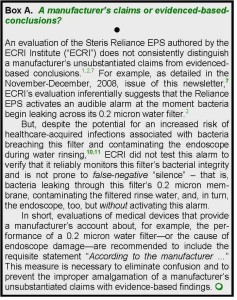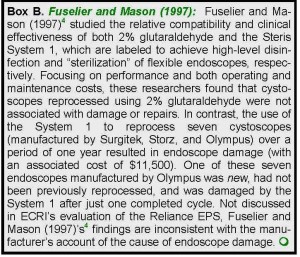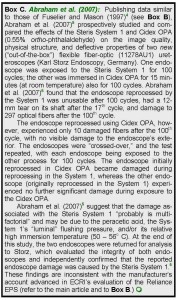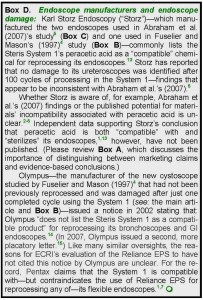This article by Lawrence F Muscarella, PhD, discusses whether 2% glutaraldehyde formulations and peracetic acid solutions, either of which may be used to achieve high-level disinfection, might cause damage to immersed flexible endoscopes, including gastrointestinal (GI) endoscopes.
This article — which is the second of two articles that discuss endoscope damage potentially caused by disinfectants and sterilants — was originally written prior to 2010, when the Steris System 1 was replaced by the Steris System 1E model. In addition, this article is based on a more comprehensive article that may be read by clicking here. Recommendations are provided herein.
BACKGROUND
Entitled “Endoscope Damage, Part 1,” the first article in this series of two focuses on the potential for endoscope damage associated with the use of peracetic acid and other types of liquid chemical disinfectants.1-7
Peracetic acid and aldehyde-based disinfectants, such as 2% glutaraldehyde (e.g., Cidex) and ortho-phthalaldehyde (e.g., Metricide OPA Plus), are commonly used to reprocess flexible endoscopes after each use, in accordance with Standard Precautions, to prevent the transmission of infectious agents.
This article herein completes this discussion about endoscope damage. A more detailed article upon which this article is based may be read by clicking here.
Click here to read the first article in this series of two focusing on endoscope damage.
INTRODUCTION
A liquid oxidizing agent that is chemically distinct from aldehyde-based disinfectants, peracetic acid is the active ingredient used by both the Steris System 1 and the Steris Reliance Endoscope Processing System (EPS), at the same concentration (0.2%) and elevated immersion temperature (50—56o C) (but at slightly different immersion times).2,6
Whether endoscope damage acknowledged to be associated with the System 1 may, therefore, also be associated with the Reliance EPS is unclear, although the possibility is discussed in an evaluation of the Reliance EPS authored by the ECRI Institute (“ECRI”).2
Dr. Muscarella’s article that provides his review of ECRI’s evaluation of the Steris Reliance EPS may be read by clicking here.7
Whereas the Reliance EPS is labeled to supplement manual cleaning and both to wash and high-level disinfect GI endoscopes, the Steris System 1 is labeled to “sterilize” several different types of instruments, including GI endoscopes.2
Having been declared in May (2008) to be “adulterated and misbranded” since 1988, the sale of the Steris System 1 in January (2009) became restricted.8,9
Dr. Muscarella’s article discussing the history of the Steris System 1 may be read by clicking here.
The misbranding of the Steris System 1, its countenanced use in the U.S. despite its discontinuation, and the lack of published position statements by infection-control organizations contraindicating the use of adulterated and misbranded devices in the healthcare setting will be discussed in a future issue of this newsletter.
REVISITING A MANUFACTURER’S CLAIM
As if in a tone of exoneration, ECRI’s evaluation of the Steris Reliance EPS recites and advances a manufacturer’s account of the cause of endoscope damage acknowledged to be associated with the Steris System 1.1-3,7
According to this account, the Steris System 1 is not responsible for endoscope damage—rather, its peracetic acid uncovers pre-existing endoscope “defects” caused by “wear and tear and/or improper care and handling” of endoscopes by staff members.2 This manufacturer suggests that aldehyde-based disinfectants (e.g., 2% glutaraldehyde and ortho-phthalaldehyde) used previously to reprocess the endoscope “mask” these pre-existing defects, which include small pin holes.
The manufacturer adds that subsequent use of the Steris System 1 “unplugs” these pin holes, clogged over time with retained protein residue, appearing to (but not) cause endoscope damage.2,3,6 (See: Box A and Box B, below.)

A CONVERSE QUESTION
In sync with this manufacturer’s account, ECRI’s evaluation of the Reliance EPS states that “ECRI has seen quite a few reports of endoscopes developing leaks or exhibiting damage after reprocessing in the System 1 sterilizer after formerly being reprocessed with other, aldehyde-based” disinfectants.2
Interestingly, ECRI’s evaluation does not complete this discussion by addressing or answering the obvious, if also requisite, converse question: Has ECRI also received (or is it aware of) reports of damage to endoscopes that had been reprocessed only in the Steris System 1 and that had not been formerly reprocessed using an aldehyde-based disinfectant?
Presumably, ECRI has received such reports of endoscope damage, but did not provide readers with insight into their contents, which is confusing.

DISCUSSION
In addition to ECRI’s evaluation of the Steris Reliance EPS, a number of published articles and studies Discuss the acknowledged association between endoscope damage and the Steris System 1.2-5
In general, each of these papers either implicates or, on the other hand, claims to rule out peracetic acid as the cause of endoscope damage. The repairing and servicing of endoscopes damaged during reprocessing can be considerable and expensive.4,5
Therefore, in addition to investigating whether these published articles are evidence-based, researching and understanding the Potential causes of endoscope damage is important.
Damage to new endoscopes
Two published studies—authored by Fuselier and Mason (1997) (see: Box B, above), and by Abraham et al. (2007) (see: Box C, below)—provide findings that are inconsistent with this manufacturer’s account that the Steris System 1’s peracetic acid “unplugs” clogged pin holes and uncovers, but does not cause, endoscope damage—an account advanced in ECRI’s evaluation of the Reliance EPS but that has not been independently substantiated.1,2,4,5
These studies (one of which pre-dates the publication of ECRI’s evaluation) report that the System 1’s peracetic acid caused measurable damage to endoscopes—including new endoscopes that not only had not been “formally” reprocessed using an aldehyde-based disinfectant, but reportedly were damaged by the System 1 after just one completed cycle.4,5
The findings of these two studies suggest that ECRI’s intimation that damage linked to the Steris System 1 is only associated with endoscopes “formerly”2 reprocessed using aldehyde-based disinfectants is in error.
In its evaluation of the Reliance EPS (and any of its subsequent publications), ECRI does not cite these two independent studies or reconcile their results with the manufacturer’s claim that the System 1’s peracetic acid does not cause endoscope damage.

Further, ECRI’s evaluation does not discuss the conspicuous possibility that peracetic acid itself might be responsible for the endoscope damage reportedly associated with the System 1 (see: Box C). The rationale for these omissions is unclear.
Glutaraldehyde, “pin holes”:
Advancing the manufacturer’s account of the causes of endoscope damage, an article published in a trade magazine contends that 2% glutaraldehyde and ortho-phthalaldehyde are cross-linking agents that can “fix” patient debris, resulting in “layers” of “organic material and/or biofilm” to “build-up” over time inside endoscopes.6
Without citing independent data to support its claims, this magazine article suggests that the subsequent use of oxidizing agents removes these layers of organic material and “unplugs” pre-existing pin holes, causing peracetic acid to appear to (but not) be the cause of endoscope damage associated with the Steris System 1.6
This magazine article, however, the claims of which are inconsistent with independent studies,4,5 appears not to have been peer-reviewed, and it was co-authored by Steris (the manufacturer of the Reliance EPS and the System 1).6
Another article similarly suggests that peracetic acid “breaks down protein encrustations,” claiming that by removing this “encrusted” patient debris, the Steris System 1’s peracetic acid uncovers (but is not the cause of) “small channel perforations” and pin holes that were “masked” by aldehyde-based disinfectants used previously to reprocess the endoscope.3 But this article, too, was not peer-reviewed and was authored by the System 1’s manufacturer.
The conclusions of these two manufacturer-sponsored articles, which are in lock-step with the account advanced in ECRI’s evaluation of the Reliance EPS,2 are inconsistent with, in addition to both Fuselier and Mason’s (1997)4 (Box B) and Abraham et al.’s (2007)5 (Box C) findings, the conclusions of Muscarella (1999), which question claims that glutaraldehyde’s chemical properties are responsible for endoscopes being “visibly encrusted with debris.”12 Muscarella (1999) adds that “clinical data demonstrating a correlation between the build-up of patient material on an instrument and the type of liquid chemical sterilant used by the hospital are lacking.”12
To be sure, independent data have not corroborated the manufacturer’s claim (advanced in ECRI’s evaluation of the Reliance EPS2) that endoscope damage attributed to the System 1 (and, possibly, the Reliance EPS2) is due, not to peracetic acid, but rather to this oxidizing agent’s uncovering of pre-existing pin holes and small channel perforations, or endoscope “defects,” that became clogged with “encrusted”3 patient debris that built up over time during previous reprocessing using 2% glutaraldehyde and other “cross-linking agents.”2,3,6
Nor have independent data been published demonstrating that an aldehyde-based disinfectant damages endoscopes. Indeed, both Fuselier and Mason(1997) (Box B) and Abraham et al. (2007) (Box C) implicate the Steris System 1 and/or its peracetic acid as the cause of endoscope damage.4,5
RECOMMENDATIONS
The following recommendations are provided to improve patient safety and minimize the likelihood of endoscope damage and costly repairs:
1. Ensure endoscopes are properly handled, reprocessed, stored, and serviced per the endoscope manufacturer’s instructions, to maintain the endoscope’s integrity, to prevent damage, and to ensure its safe and long-lasting functioning.
2. Only use high-level disinfectants, sterilants, or other reprocessing agents verified via documentation, certified and controlled by the instrument manufacturer’s quality assurance department, to be compatible with each endoscope (and automated endoscope reprocessor) model in inventory.
3. Work to improve infection control standards by requiring that:
- conflicts of interest in infection control be more rigorously managed;
- healthcare organizations publish timely infection-control position statements—for example, contraindicating the use of adulterated and misbranded medical devices;8,9 and
- endoscope manufacturers publish reprocessing instructions that display more of a commitment to evidence-based conclusions and patient safety (see: Box D, below), and that, unless supporting data are available, these manufacturers not claim that their endoscopes are “compatible” with certain reprocessing agents or that these agents are safe and effective (see: Box A).
4. Last, these additional recommendations are provided to improve the quality of infection-control guidelines and evaluations of the performance of medical devices, including infection-control products:
- distinguish more conspicuously a manufacturer’s claim from an evidence-based (scientific) finding;
- use caution before advancing a manufacturer’s unsubstantiated claims—for example, consider and publish in the guideline or evaluation all possible causes, not just one, of endoscope damage; and
- also for balance and perspective, discuss and cite studies whose findings or conclusions are inconsistent with a position, scenario, or recommendation advanced in the guideline or evaluation.

This article’s references are available here.
Article by: Lawrence F Muscarella PhD, updated 5-15-2014, Rev A.